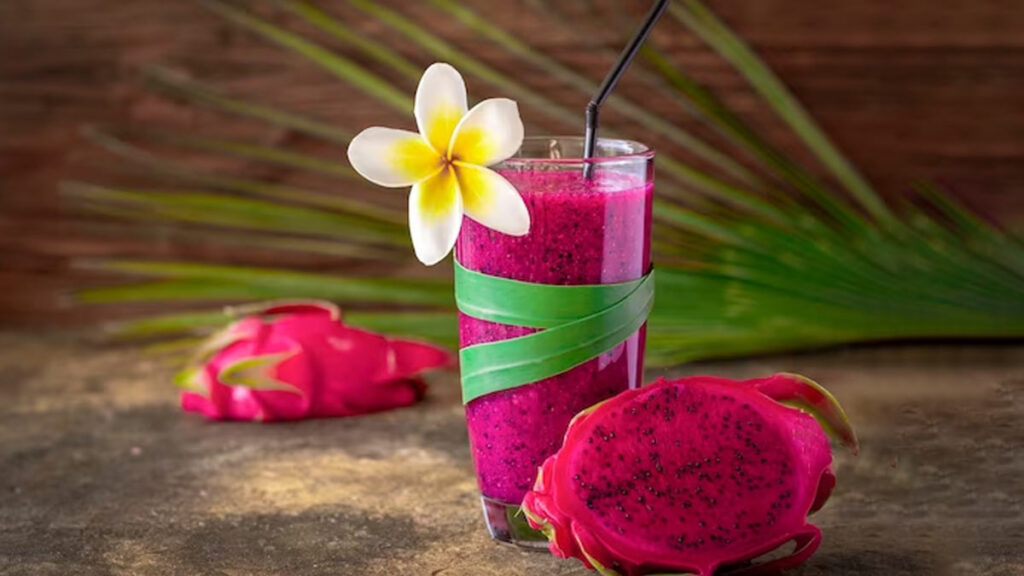The pink dragon fruit stands out as a beautiful gem among the many exotic fruits. It is praised for both its beautiful look and the many health benefits it offers to those who eat it. In this investigation, we will examine the aspects of taste, cultivation, and possible benefits that make pink dragon fruit a valuable food and dietary supplement.

Pink dragon fruit benefits
1. Bounty Antioxidant
Antioxidants exist in the pink dragon fruit, especially betalains and vitamin C. By reducing oxidative stress and strengthening the body’s defences against free radicals, these substances improve general health.
2. Vitamin-Heavy Liquid
Pink dragon fruit is notable for its iron and phosphorus content, which supports essential bodily processes. Iron helps the blood carry oxygen, while phosphorus is essential for healthy bones and energy metabolism.
3. Mineral Magic:
Iron and Phosphorus The pink color dragon fruit, rich in vital vitamins including vitamin C, B vitamins, and vitamin A, provides a nourishing drink that boosts skin health, immunity, and energy metabolism.
4. Dietary Fibre for Digestive Wellbeing:
The pink dragon fruit contains dietary fibre, which helps to support digestive wellbeing. Fibre promotes regular bowel movements, keeps diarrhoea at a distance, and increases feelings of fullness.
Pink dragon fruit price
Curiosity about the dynamics of the pink dragon fruit market is growing along with the fruit’s appeal. Factors including demand generally, seasonal availability, and geographic location affect this exotic fruit’s price. Despite the possibility that it is a luxury fruit, its value in terms of nutrition and aesthetics justifies its position in the market.
Taking care of a dragon fruit plant can be a fulfilling project for people who enjoy gardening. For devotees, the satisfaction of picking their pink treasure goes beyond financial considerations.
Pink Dragon Fruit Plant

The pink dragon fruit’s journey starts with the careful care of its host, Hylocereus undatus. This vine-like cactus needs well-draining soil and a warm temperature to thrive. It is well-known for its sprawling branches and nighttime flowers. The focal point of this amazing plant is the magenta-coloured fruit with green scales.
The pink dragon fruit plant opens its night blossoms, which become the colourful fruits we love after they are fertilised. The fruit is unique not just because of how beautiful it is on the outside but also because of all the nutrients it contains.
Pink dragon fruit taste
1. Initially Sweet with Floral Undertones
The dragon fruit’s sweetness plays out in the first bite, creating a lovely symphony with floral flavours. The first sweetness rush is like a soft hug for the taste buds.
2. Mild Acidity for Balance
A delicate tanginess dances on the tongue in contrast to the sweetness, achieving a perfect balance that improves the entire taste profile. This tropical treat gains richness from the contrast of these flavours.
3. Refreshing and Juicy Texture
The pink dragon fruit’s amazing and refreshing texture is revealed as you savour its delectable flesh. It’s the perfect fruit for anyone looking for something pleasant and hydrating because every mouthful is a refreshing experience.
4. Nutritious Layers
Certain types of dragon fruit in pink enhance the flavour experience by surprising the taste buds with subtle, creamy undertones. These delicate undertones give the overall flavour profile more complexity and take the senses on a diverse adventure.
Pink dragon fruit vs white
Comparing Shades: Pink vs. White Dragon Fruit
Fans frequently wonder what makes the dragon fruit different from its white-hued counterpart. Despite coming from the same botanical family—Hylocereus—they are distinguished by differences in pigment composition and subtle flavour.

1. A range of pigments
Whereas betaxanthins give the white dragon fruit its colour, betacyanins are responsible for the vivid pink colour of the pink version. These pigments have clear antioxidant advantages in addition to adding to their aesthetic appeal.
2. Distinctions in Flavour
When it comes to flavour, the dragon fruit in pink is usually sweeter than the white one. The flavour profile is influenced by the presence of betacyanins, which impart a distinct and slightly more intense sweetness.
3. Similarities Among Nutrients
In terms of nutrition, both types are comparable in that they contain antioxidants, vitamins, and minerals. Often, one’s individual taste and aesthetic preferences will determine which option is best.
Pink Dragon Fruit Juice:

1. Reviving Water
Juice from the dragon fruit pink is extracted, producing a drink that is all about rejuvenating hydration. Drinking this colourful concoction is not just a delicious experience but also an eye-catching one.
2. Innovative Cooking Investigation
Pink dragon fruit juice isn’t just for drinking out of a glass. To give a distinctive touch to their creations, culinary lovers frequently experiment with mixing the juice into different foods, such as sauces and desserts.
Pink dragon fruit during pregnancy
The pink dragon fruit has an attraction that some expectant mothers may find appealing. The fruit can support a nutrient-rich diet for the mother and the developing child, but moderation is crucial.
1. Folic Acid for Brain growth
For expectant mothers, the iron found in dragon fruit pink is especially significant since it helps the foetus form its neural tube during the critical early phases of its development.
2. Rehydrate and Boost Your Nutrients
Expectant moms trying to stay nourished will find the dragon fruit pink to be a refreshing and nutritious option due to its hydration qualities and variety of vitamins and minerals.
To learn more about dragon fruit during pregnancy, click here.
In summary, the pink dragon fruit is more than just an unusual treat; it is a symbol of the creative and abundant nutritional abilities of nature. The pink dragon fruit invites us to take part in a sensory adventure that honours the wonders of nature, whether we are enjoying its sweet and tangy taste, learning about its health advantages, or thinking about the dynamics of cultivation and market pricing.
